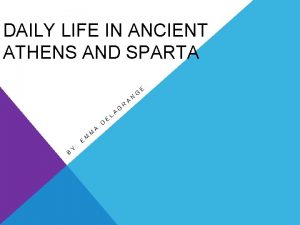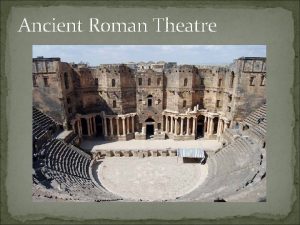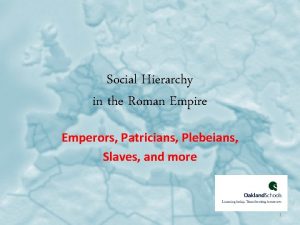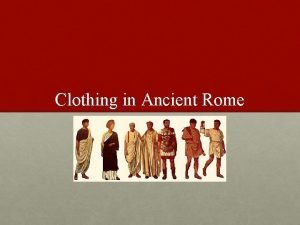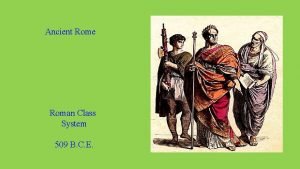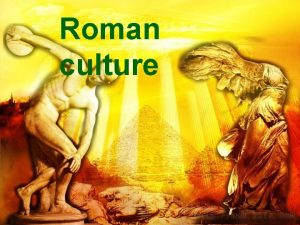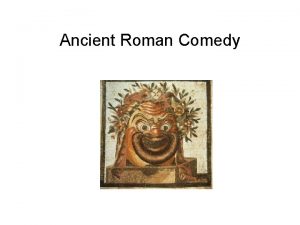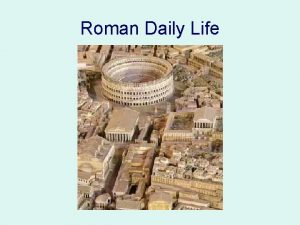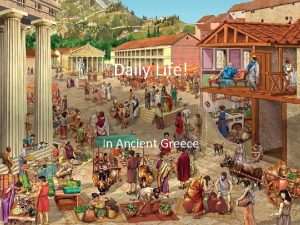Roman Religion Lares Lares Daily Life in Ancient



























- Slides: 27

Roman Religion: Lares, Lares Daily Life in Ancient Rome w/ Mr. C


Next Time Food Bathrooms Religion (3/12) Women & Marriage (3/19) War (3/26) Home Life (4/2) City Life (4/16) Y mucho, mucho mas! (4/23 & 4/30)

Superstitions of Rome Spirits could be found in inanimate objects such as stones, rivers, furniture, and even caves. Children were told horrifying stories of monsters who would come to kill them if they misbehaved. Herbs could do many good things. (i. e. -they "made enemies retreat in battle" and they "opened closed doors") Animals are heavily associated with superstitions. People wore or carried amulets and lucky charms in order to avoid evil. Bees were good fortune; godly messengers An owl sighting meant "impending disaster. " Warts could be removed if the person who had one took their mother's dirty dishcloth and put it under a rock outside. If somebody threw a horseshoe, good fortune could be gained by picking it up. It was unlucky to "attack the memory of a deceased person. " It was a good idea to wait until after breakfast to tell somebody about a nightmare. Odd numbers were "more powerful" than even ones. And many, many more!

Roman Prayers Requests and prayers were presented to gods as a trade: if the god did what was requested (the nuncupatio), then the worshipper promised to do a particular thing in return (the solutio). This trade was binding. In a sense, they were legal documents that could obligate gods for particular action and protection. Religion depended on knowledge and the correct practice of prayer, ritual, and sacrifice, not on faith or dogma.

Ehh, Close Enough Roman religion was thus practical and contractual, based on the principle of do ut des, "I give that you might give. " All sacrifices and offerings required an accompanying prayer to be effective. Pliny the Elder declared that "a sacrifice without prayer is thought to be useless and not a proper consultation of the gods. “

Roman Gods The three most important gods were: Jupiter (protector of the state), Juno (protector of women) and Minerva (goddess of craft and wisdom). Other major gods included: Mars (god of war), Mercury (god of trade and messenger of the gods) and Bacchus (god of grapes and wine production).

Optimus Maximus (Greatest & Bestest) The God Jupiter depicted in sculpture

Divine Rule Aeneas and Romulus themselves were believed to have been made gods after their deaths and the family of Augustus traced their roots back to these divine ancestors. As a result, the fact that Julius Caesar and his descendants were made into gods after they died was not just a way of honoring their achievements in power, it was also simple recognition of the fact that they belonged to a divine family. Over time, the same divinity was extended to wives and children. The whole imperial family came to be seen as gods and was often commemorated with temples and coins.

The Lares (Household Spirits) Etruscans practiced domestic, ancestral or family cults very similar to those offered by later Romans to their Lares. The word itself seems to derive from the Etruscan lar, lars, or larth, meaning "lord".

At a Crossroads They were originally gods of the cultivated fields, worshipped by each household at the crossroads where its allotment joined those of others. Later the Lares were worshipped in the houses in association with the Penates, the gods of the storeroom (penus) and thus of the family’s prosperity; the household Lar (Familiaris) was conceived as the centre of the family and of the family cult.

How many Lares? Originally each household had only one Lar. It was usually represented as a youthful figure, dressed in a short tunic, holding in one hand a drinking horn, in the other a cup. Under the empire, two of these images were commonly to be found, one on each side of the central figure of Vesta, or of some other deity. (We will come back to Vesta because she is important!)

How to honor the Lares & Penates It was at the hearth sacrifices were made to the gods and the spirits of the families ancestors. If the fire was to burn on forever, then it was only when the family moved away to another home, that the fire would be put out with wine in a small ritual. They were represented by little figurines which would be kept in a special cupboard. Among them the lar familiaris, the family spirit, was the most important. Lares – everyday prayers Extra Special days: weddings, birthdays, calends (first days), ides (middle), nones (9 th day) Penates – thanks for keeping the family fed; statues placed on dinner table, then put away

WHAT!? !? A THIRD god/spirit! The third household spirit of note was the genius. Could be represented in form of a snake. Vesta was also a common genius. Occasionally an ancestor too (if he was ‘famous’). The genius of the household was particularly celebrated on the head of the family's birthday.

What about evil spirits? Romans were superstitious. Apart from friendly spirits there were also ghostly spirits of the dead which might haunt a house. They were the so-called larvae and lemures. These could be driven out of the house by ritual, performed by the head of the family, which involved spitting our black beans and noisily bashing together metal pots.

Household gods Two gods of the Roman state cult guarded the private homes of the Roman citizen. Janus, the god of doorways and beginnings. It was he who was seen as the chief guardian of the home. His was the passage through the door, he was both inside and outside the house at once. Hence he was its guardian. not to be the only god in care of the door : Cardea, the goddess of hinges Forculus, god of the door leaves Limentius, the god of the threshold Vesta, the goddess of the hearth. As the hearth was of practical importance (for cooking) and of spiritual significance (sacrifices) it is quite understandable that Vesta was seen to be of great importance to a Roman's home. Every day prayers would be said to Vesta. During meals some food might be set aside and passed into the fire as an offering to the goddess.

Vesta – at home Vesta, in Roman religion, goddess of the hearth, identified with the Greek Hestia. The lack of an easy source of fire in the early Roman community placed a special premium on the everburning hearth fire, both publicly and privately maintained. Her worship was observed in every household along with that of the Penates and the Lares, and her image was sometimes encountered in the household shrine.

Vesta – in the city (Urbs) The state worship of Vesta was much more elaborate. The Temple of Vesta was traditionally a circular building, in imitation of the early Italian round hut and symbolic of the public hearth. There burned the perpetual fire of the public hearth attended by the Vestal Virgins. Vesta is represented as a fully draped woman, sometimes accompanied by her favourite animal, a donkey. As goddess of the hearth fire, Vesta was the patron deity of bakers, hence her connection with the donkey, usually used for turning the millstone, and her association with Fornax, the spirit of the baker’s oven.

Vesta – in the city (Urbs) The only man who could enter the temple of Vesta was the Pontifex Maximus.

Temples

Temples Aedes Iovis Optimi Maximi Capitolini

Rome – the Eternal City

Rome, just one big family The public side of religion was more organized and more formal than the private. At home, the pater familias – head of the family – performed religious rituals for the household. Beyond the home, gods were worshipped by the state, which employed colleges of highly trained priests and priestesses. The Pontifex Maximus was the highest pontifex or priest in ancient Rome -- like the modern Pope. Also like the Pope, once in office, the appointee held his position for life.

Roman “Priests” The priesthoods of public religion were held by members of the elite classes. There was no principle analogous to "separation of church and state" in ancient Rome. During the Roman Republic (509– 27 BC), the same men who were elected public officials might also serve as augurs and pontiffs. Priests married, raised families, and led politically active lives. Julius Caesar became Pontifex Maximus before he was elected consul. The augurs read the will of the gods and supervised the marking of boundaries as a reflection of universal order, thus sanctioning Roman expansionism as a matter of divine destiny. The Roman triumph was at its core a religious procession in which the victorious general displayed his piety and his willingness to serve the public good by dedicating a portion of his spoils to the gods, especially Jupiter, who embodied just rule.

Pontificus Maximus The Pontifex Maximus was the highest pontifex or priest in ancient Rome -- like the modern Pope. Also like the Pope, once in office, the appointee held his position for life. The Pontifex Maximus chose the Vestal Virgins, the flamines, and the rex sacrorum. The Pontifex Maximus was, in some sense, the heir of the king (rex) who once ruled the Romans, according to their legendary history. Roman emperors held the title of Pontifex Maximus.

Caesar Augustus The Pontificus Maximus was not a magistrate and didn't wear the striped toga (toga praetexta). When presiding at ceremonies, he pulled his toga over his head.

Other Priests The earliest priests are thought to have been the flamines, who were devoted to individual gods. The Flamen Dialis, who was devoted to Jupiter, was subject to many prohibitions and duties, but also enjoyed honors. Another type of priest going back to the legendary period is the pontifex (pl. pontifices) who were not restricted to specific gods, but served as superintendents to the worship of all gods. The Pontifex Maximus came to replace the rex sacrorum in his responsibility for the vestal virgins, but the rex sacrorum maintained his responsibility to announce the fixed festival days (feriae), written on the calendar. There were also augures (priests who took the auspices), decemviri sacris faciundis ([half plebeian, and half patrician] who took care of the Sibylline books and were appointed for life), Sodales Fratres Arvales (9 or 12 who offered sacrifices for fertility of the field), Sodales Luperci, Sodales Salii (12 [patrician] priests of Mars Gradivus). In addition to these priests, there were other, minor offices, some held by men, and others by women: the wives of the flamen and the rex sacrorum (flamenica and regina sacrorum) and the Vestal Virgin priestesses.
 Valores universales lucía amanda negrete lares
Valores universales lucía amanda negrete lares Daily life in athens and sparta
Daily life in athens and sparta Rich and poor romans
Rich and poor romans Daily life of a roman citizen
Daily life of a roman citizen Daily life in the roman empire
Daily life in the roman empire Polynomials in real life situation
Polynomials in real life situation Secneer
Secneer 221 ad
221 ad Sparta gods and goddesses
Sparta gods and goddesses Roman religion
Roman religion Ancient and modern communication
Ancient and modern communication Ancient india vs ancient china
Ancient india vs ancient china Byzantine period floral design
Byzantine period floral design Poor roman food
Poor roman food History of clowns
History of clowns Ancient rome theatre
Ancient rome theatre Roman domus
Roman domus Ancient roman toothbrush
Ancient roman toothbrush Ancient rome dance
Ancient rome dance Ancient rome landmarks
Ancient rome landmarks Ancient roman deities most resembled
Ancient roman deities most resembled Roman empire social structure
Roman empire social structure Ancient roman children's clothing
Ancient roman children's clothing Ancient roman class system
Ancient roman class system Roman bryant
Roman bryant Politheistic
Politheistic Roman republic vs roman empire
Roman republic vs roman empire Anomalous expansion of water
Anomalous expansion of water

